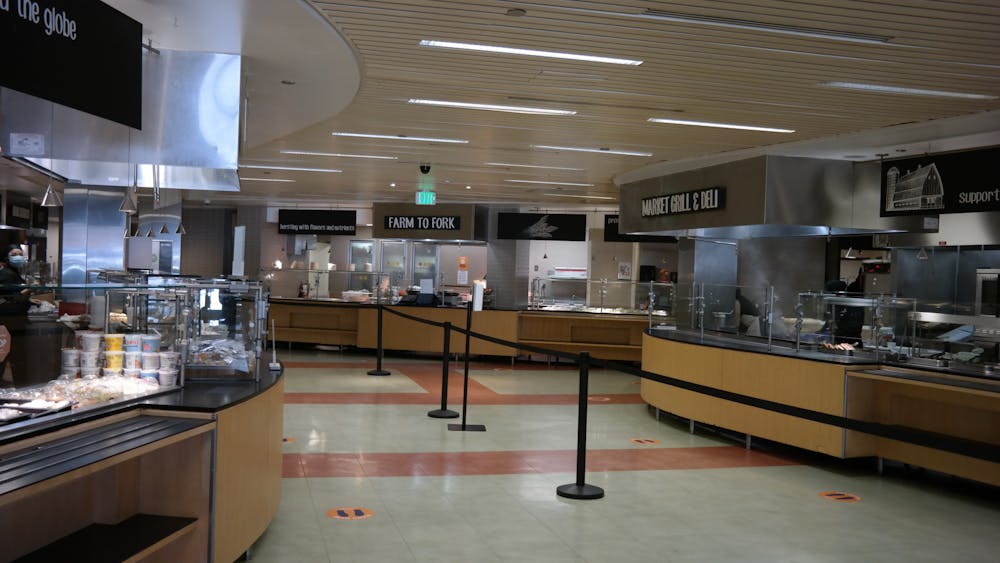As a part of COVID-19 precautions, the University has increased grab-and-go meals from dining halls and indoor events. In interviews with The News-Letter, University constituents discussed how the pandemic has affected sustainability measures on campus.
Waste Reduction and Recycling Manager Leana Houser provided an overview of sustainability challenges faced by Hopkins and its peer institutions throughout the pandemic.
Houser asserted that issues are arising from nationwide material shortages.
“[COVID-19] has led to massive supply-chain shortages at colleges and universities all over the country,” she said. “Everyone is dealing with this, [and] everyone is struggling.”
Houser explained that third-party vendors often lack the resources to deliver environmentally friendly packaging for food products because they lack large-scale manufacturing resources. Although University dining services had transitioned to offering solely compostable grab-and-go packaging before the pandemic, this progress was disrupted by the onset of COVID-19.
Moreover, Houser pointed out that achieving net-zero waste is even more difficult at non-cafeteria-style campus dining services such as CharMar.
“For retail, salads and sandwiches come from third-party local caterers. Sometimes our commitments to supporting the local economy and minority business enterprises conflict with our sustainability commitments when compostable materials are usually at a much higher price,” she said.
She noted that a significant obstacle to sustainability on campus is that some brands of to-go packaging contain petroleum-based plastic rather than bioplastic.
Freshman Jasmine Wu noted that a lack of awareness could potentially build unsustainable habits in an interview with The News-Letter.
“The University needs to educate people on what is and what isn’t compost,” she said. “Everything is just ending up in the trash.”
According to Houser, the University will put up signage near all cafeteria exits to explain how to sort compostable grab-and-go products.
The Fresh Food Café (FFC) and Nolan’s provide compostable packaging for all food items, Houser noted. She advised people to pay attention to grab-and-go items’ materials to see how they should be disposed and to look for labels like “compostable” or “PLA” on items, which designate biodegradable status.
Houser expanded on waste disposal guidelines in her interview.
“Everything that is made from paper, all the paper coffee cups and paper to-go containers, anything like that — yes, it’s compostable,” she said. “But if you go to CharMar or Levering, you will have to check the plastic container until we get back to pre-COVID[-19] days when things were reliably compostable.”
Freshman Valerie Tu, who regularly dines at FFC, raised concerns about unnecessary waste at dining halls in an interview with The News-Letter.
“I find it frustrating when people use takeout boxes in the dining hall,” she said. “If you can use a plate, use a plate.”
Tu also emphasized that students should be more responsible for their own waste and trash rather than throwing everything onto the conveyor belts offered at FFC and Nolan’s.
Houser noted that the Office of Sustainability and the Office of Residential Life conducted a joint audit across all campus dining facilities in 2018, which the University used to guide its waste management and outreach programs. Among other findings, the audit revealed that many locations had compostable contaminants in incinerate bins because of a shortage of compost bins and that at several locations including Brody Learning Commons (BLC) and the Milton S. Eisenhower Library (MSEL) , compost bins overflow.
In an email to The News-Letter, Houser explained how the University has adjusted its waste management and outreach based on the audit.
“We doubled up on compost bins at waste bin stations with high usage in the BLC and MSEL, [and] Housing ordered more compost bins and... better signage where it was missing,” she wrote. “We completely redesigned our waste signs..., [and] the outreach campaigns shifted to common contaminants like coffee cups that were being recycled instead of composted.”
Freshman London Craddock added that the way food is served also contributes to excessive trash, something which could be remedied with smaller portions in an interview with The News-Letter.
“I think 70% of our food waste is due to people getting food they do not like in huge portions because the lunch staff is directly serving the food,” he said.





